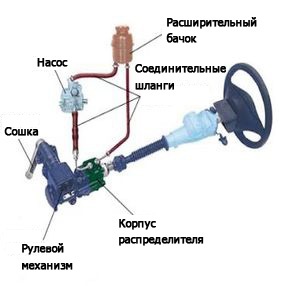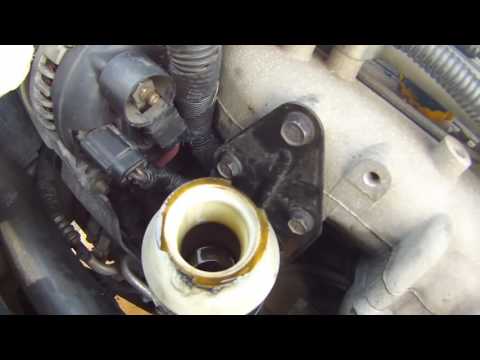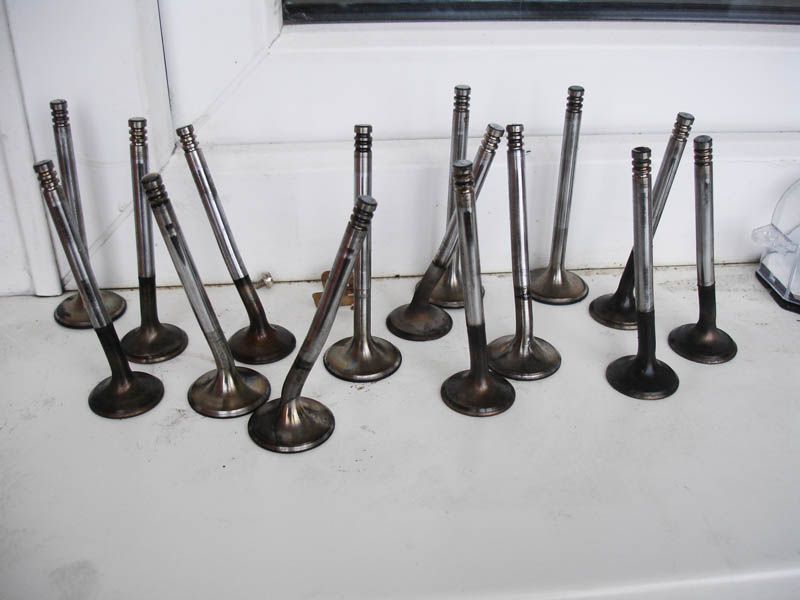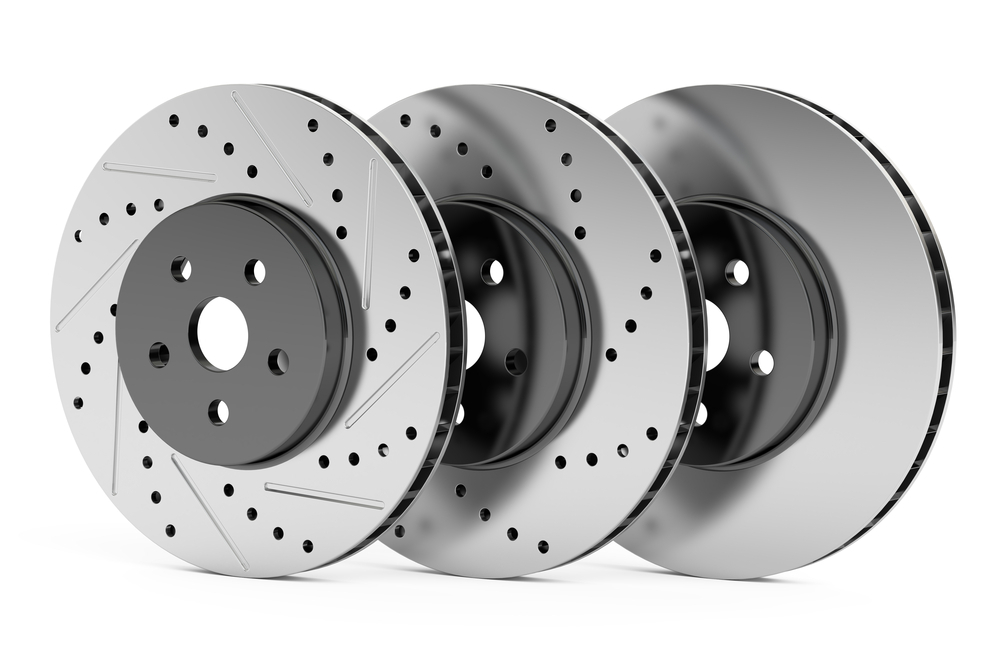
Power steering pumping
Content
Power steering scheme
Power steering pumping and its systems is carried out when replacing the working fluid, airing, which may be the result of a breakdown or repair work. The air that got inside not only reduces the efficiency of the hydraulic booster, but can also cause serious damage, namely, the failure of the power steering pump. That's why pumping the hydraulic booster must be carried out in strict accordance with existing technology.
Signs of malfunctions in the power steering system
There are several signs of airing the power steering system, in which it is necessary to bleed it. Among them:
- the appearance of strong noise in the area where the power steering or its pump is installed;
- increase in pressure on the steering wheel, difficulty turning it;
- leakage of working fluid from the power steering system.
In addition, there are also several signs indicating airing of the system — foam formation on the surface of the working fluid in the expansion tank, spontaneous steering wheel turns to one side. If you are faced with at least one of the described signs, then you need to pump the power steering.
How to pump power steering

How to fill in oil and pump power steering
The procedure for replacing the fluid and pumping the power steering is carried out in strict accordance with the existing algorithm. Some automakers may add their own features to it. If you have a manual for your car, we recommend that you read the appropriate section. In general terms, the steps must be performed in the following sequence:
- Raise the machine completely on a lift or hang its front wheels.
- If necessary, drain the old fluid from the expansion tank. To do this, remove the return hose (going to the power steering system) from the expansion tank and put a plug on it so that the liquid does not spill out of the hose. A hose is attached to the released faucet on the tank, which goes to an empty bottle, where it is supposed to drain the old hydraulic fluid.
- the base volume of liquid is most conveniently pumped out with a syringe and poured into a separate bottle. When there is very little liquid left, move on to the next step.
- Fill the expansion tank with working fluid up to the top.
- then you should turn the steering wheel from side to side (from lock to lock) several times so that the old liquid remaining in the system flows out through the hose. Since the new fluid displaces the old one, do not forget to monitor the oil level in the tank so that air does not get into the hose.
- When the liquid level drops, top up it again.
- Run the engine for 2-3 seconds and shut it off. This is done in order for the liquid to begin to spread through the system.
Pumping oil with a syringe
- then you should add the working fluid to the tank to the level of the MAX mark and repeat the procedure with the start of the internal combustion engine. Repeat this cycle 3-5 times.
- The signal to stop pumping is the fact that air from the return hose stops getting into the drain bottle. This means that there is no more air left in the hydraulic system, and fresh, clean fluid enters the reservoir.
- After that, you need to reinstall the return hose (connect to the expansion tank where it was originally installed).
- Refill the tank to the MAX level, then start the internal combustion engine.
- To pump the hydraulic booster, you need to slowly turn the steering wheel 4-5 times from the left to the right stop. In places of stops, pause for 2-3 seconds. If air remains, it must exit into the expansion tank. In the process of checking, we make sure that the pump does not make extraneous noise.
- The signal that the pumping has ended will be the absence of air bubbles on the surface of the liquid in the tank.
- Then close the expansion vessel tightly.

Bleeding the power steering system
System bleeding it is also possible to carry out without engine start, “Cold”. For this it is enough to turn the steering wheel from left to right stops. In this case, the old fluid and air exit the system. However, most auto manufacturers still advise to bleed the system with the ICE running.
The liquid level in the reservoir must be between the MIN and MAX marks... Remember that liquid expands as it heats up, so do not overfill.
Typical breakdowns of the power steering
breakdowns in the operation of the hydraulic booster are easy to identify by characteristic signs. Among them:
- Steering wheel turns tight... Probable reasons are the failure of the power steering pump, the use of an unsuitable working fluid, sticking of the channels of the spool mechanism.
- When the steering wheel is turned all the way (in any direction) during driving, high frequency sound (similar to a whistle). The likely cause is a loose drive belt.
- Steering wheel jerks. The probable causes of the breakdown are the non-compliance of the working fluid with the specification declared by the manufacturer, the breakdown of the fluid distribution mechanism, the breakdown of the pump.
- Intense foaming in the expansion tank. Probable causes are mixing of liquids of different types, breakdown of the power steering pump.
- When the internal combustion engine is running, spontaneous rotation of the steering wheel in any direction... The probable reason is the malfunctioning of the spool mechanism, most often, clogging of its working channels, incorrect assembly (for example, after installing a repair kit).
Recommendations for the operation and maintenance of power steering
In order for the power steering and its system to work normally, as well as to extend their service life, you need to follow a few simple rules:
General view of the power steering
- use working fluids, recommended by the car manufacturer, as well as carry out their timely replacement (most car manufacturers recommend replacing power steering fluid through every 60…120 thousand kilometer run, or once every 2 years, it depends on the driving style and the intensity of the car's use);
- perform pumping the power steering system in strict accordance with the algorithm described above (or observing separate requirements, if any, set by the car manufacturer);
- monitor the state boot, steering rack, because if it is torn, then dust and dirt will enter the system, which leads to an exit from the power steering pump. A sign of a problem that has already happened is the hum of the power steering, which is not eliminated even by replacing the fluid.
The cost of replacing fluid and pumping power steering
If you plan to carry out work on replacing the fluid and pumping the power steering yourself, then you will only need to buy oil in a volume of 1 to 3 liters (including flushing, while the volume of the power steering system of a car is up to 1 liter). The price of the liquid depends on the brand and store. It is in the range of $ 4 ... 15 per liter. If you do not want or cannot do such work yourself, contact the service station for help. Approximate prices for January 2017 years make up:
- work on fluid replacement - 1200 rubles;
- power steering pumping - 600 rubles.
Hack and predictor Aviator
Bleeding the hydraulic booster is a simple procedure that even an inexperienced car enthusiast can handle. The main thing is to follow the sequence of actions discussed above. also need to use working fluid with the characteristics recommended by the manufacturer. At the slightest sign of a breakdown in the power steering system, preventive procedures must be carried out. Otherwise, the system may fail, which threatens not only repair but also loss of vehicle control on the road.

